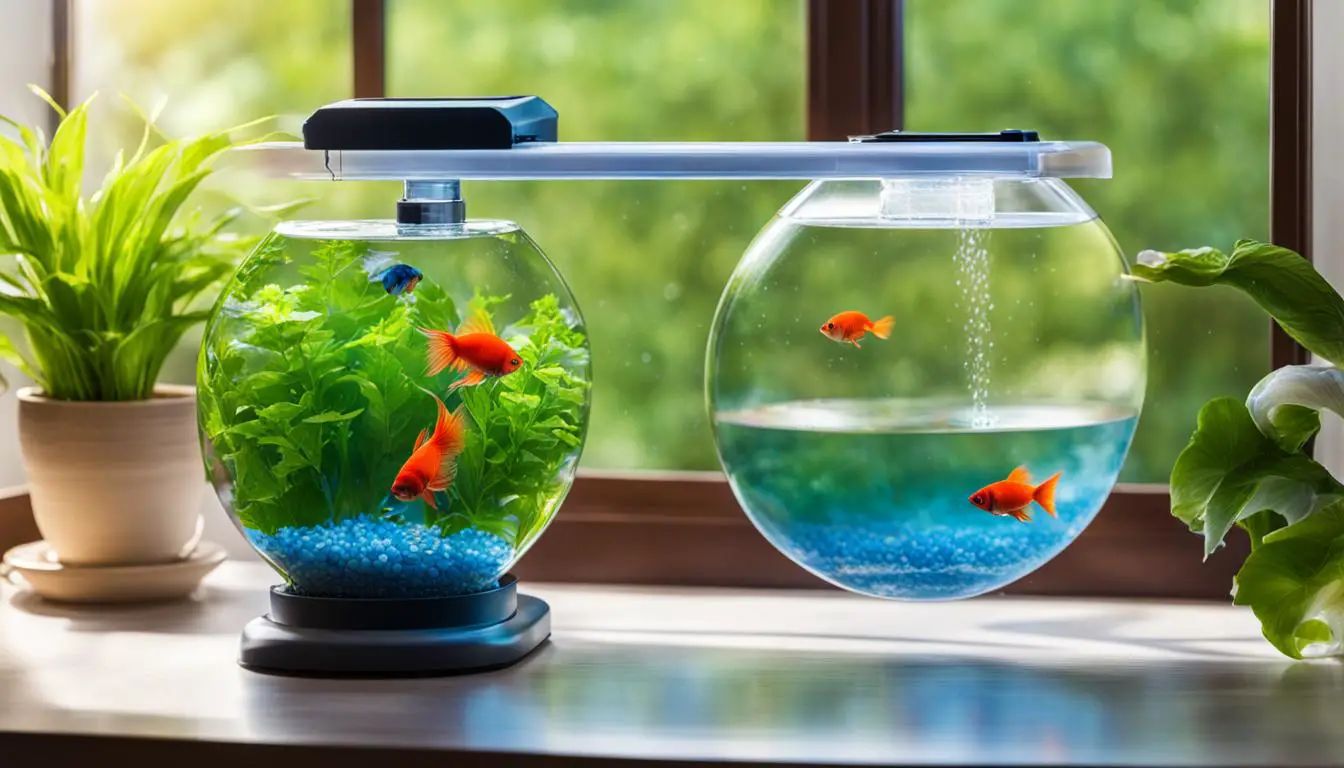Last Updated on 4 months by admin
If you’re a betta fish owner, you know that keeping your fish healthy and comfortable is a top priority. One way to ensure their well-being is by maintaining the right temperature in their tank. Betta fish require warm water to thrive, and if the temperature is too low, they can become lethargic and prone to illness. In this comprehensive guide, we’ll provide you with easy-to-follow steps on how to effectively warm up your betta fish tank.
Key Takeaways:
- Maintaining the right temperature is crucial for the health and comfort of your betta fish.
- Low temperatures can make betta fish lethargic and prone to illness.
- Follow these tips to ensure a cozy environment for your fish.
Why is maintaining the right temperature important for a betta fish tank?
Maintaining the right temperature is crucial for the health and comfort of your betta fish. Betta fish are tropical fish and require a specific temperature range to thrive. The optimal temperature for a betta fish tank is between 76°F and 82°F (24°C and 28°C).
When the water temperature is too low, bettas become lethargic and may not eat, making them vulnerable to disease and stress. On the other hand, if the water is too warm, bettas may become hyperactive and stressed, leading to aggressive behavior and health problems.
Without proper temperature regulation, your betta will not be able to survive and will eventually die. Therefore, it is essential to follow betta fish tank warming tips to maintain optimal temperature conditions for your fish.
Factors affecting the temperature in a betta fish tank
There are several factors that can affect the temperature in a betta fish tank, including:
- The size of the tank
- Location of the tank
- The ambient room temperature
- The type of fish tank heater used
It is essential to take these factors into consideration when setting up your betta fish tank. By doing so, you can ensure that your fish has a comfortable environment to live in.

“Maintaining the right temperature is crucial for the health and comfort of your betta fish.”
Choosing the Right Betta Fish Tank Heater
When it comes to selecting the best way to warm up a betta fish tank, choosing the right heater is critical. But with so many options on the market, it can be challenging to decide which one to go for. Here, we’ll guide you through the different types of betta fish tank heaters and how to choose the best one for your tank.
Types of Betta Fish Tank Heaters
There are three main types of betta fish tank heaters: immersible heaters, submersible heaters, and substrate heaters.
- Immersible heaters: These heaters sit outside the tank and heat the water through a heating element that is submerged in the water. They’re less expensive than other types of heaters, making them a popular option.
- Submersible heaters: These heaters are fully submersible in the water and can be placed horizontally or vertically. They have a thermostat that regulates the temperature and are typically more accurate than immersible heaters.
- Substrate heaters: These heaters are placed under the substrate of the tank and heat the water from the bottom up. They’re less commonly used and can be challenging to install.
The most popular betta fish tank heaters are submersible heaters, as they offer precise temperature control and are easy to install.
Factors to Consider When Choosing a Betta Fish Tank Heater
When selecting a heater for your betta fish tank, there are several factors to consider:
| Factor | Considerations |
|---|---|
| Size of your tank | The size of your tank will determine the wattage of the heater you need. A general rule of thumb is to have 5 watts of heating power for every gallon of water. |
| Temperature range | Ensure the heater you choose can heat your tank to the desired temperature range. |
| Quality | Invest in a high-quality heater to avoid malfunctions and temperature fluctuations. |
| Price | There are heaters available at various price points. Determine how much you’re willing to spend and choose a heater that fits your budget. |
Keep in mind that a reliable heater is a crucial investment in the overall health and happiness of your betta fish.
Conclusion
Choosing the right betta fish tank heater is a crucial step in providing a cozy and comfortable environment for your betta. Look for a high-quality, submersible heater that can maintain a consistent temperature in your tank, is appropriately sized for your tank, and fits your budget. By following these tips, you’ll ensure that your betta fish is healthy and happy in their warm home.

Placing the heater in the betta fish tank
Proper placement of the heater in your betta fish tank is crucial for effective temperature regulation. The goal is to ensure even distribution of heat and maintain a stable temperature for your fish. Here are some expert tips:
- Place the heater near the filter outflow for optimal circulation of heated water.
- Ensure the heater is fully submerged in the water.
- Avoid placing the heater too close to any decorations or the tank walls, which can cause uneven heating and potentially harm your fish.
- Place the heater in a location that allows for easy adjustment and monitoring.
By following these simple tips, you can ensure your betta fish tank is heated correctly, creating a comfortable and healthy environment for your fish.
Important note:
Always remember to turn off the heater and unplug it before removing it from the tank or performing any maintenance. This is for your safety and the safety of your fish.
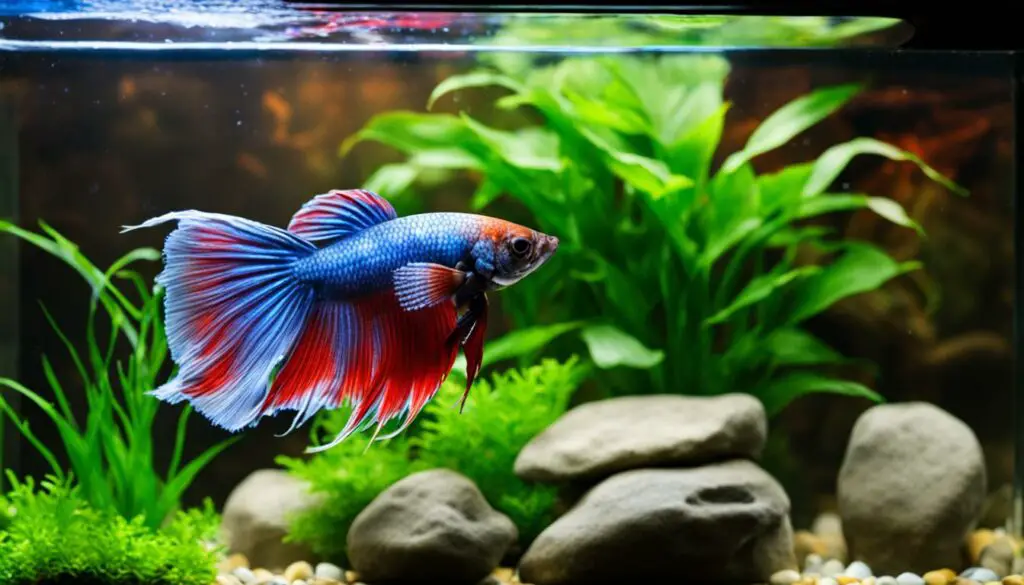
“Proper placement of the heater in your betta fish tank is crucial for effective temperature regulation.”
Setting the desired temperature on the betta fish tank heater
After choosing the right betta fish tank heater, setting the desired temperature is the next step. You’ll need to adjust the thermostat on the heater to the temperature range suitable for betta fish.
For most betta fish, the optimal temperature range is between 75 to 82 °F (24 to 28 °C). However, some bettas may require a slightly different temperature range, so it’s essential to research your specific betta’s needs.
Once you’ve determined the optimal temperature range for your fish, use the heater’s thermostat to adjust the temperature. Avoid setting the heater to the maximum temperature, as this can lead to overheating and harm your fish. Instead, aim to maintain a consistent and safe temperature range that suits your betta.
Remember to monitor the temperature regularly to ensure it stays within the desired range. If the temperature deviates from the ideal range, adjust the thermostat accordingly.

Pro Tip: When adjusting the heater’s thermostat, do so in small increments to avoid sudden temperature spikes or drops that can stress out your betta fish.
Monitoring and Adjusting the Tank Temperature
Regular monitoring and adjustment of the betta fish tank temperature is crucial to ensuring the comfort and well-being of your fish. Here are some practical tips on how to regulate and maintain the right temperature:
- Invest in a reliable thermometer to accurately monitor the temperature
- Check the temperature daily at the same time to ensure consistency
- Adjust the heater accordingly if the temperature fluctuates
- Monitor the temperature during seasonal changes as external temperatures can affect the tank temperature
- Observe your betta’s behavior to check for signs of discomfort caused by temperature changes such as lethargy or loss of appetite
By carefully regulating and monitoring the temperature, you can ensure that your betta fish are comfortable and healthy in their home.

“A consistent and stable temperature is vital for the health and comfort of your betta fish.”
Additional ways to warm up a betta fish tank
Aside from using a heater, there are other techniques you can employ to increase the temperature in your betta fish tank. Here are some betta fish tank warming tips:
- Invest in a hood with a built-in light: A hood with a built-in light can provide extra warmth for your tank. Make sure to choose a light that emits heat, like an incandescent bulb.
- Use a heat lamp: A heat lamp can be placed above your tank to provide additional warmth. Just make sure to keep it at a safe distance from the water surface and use a thermometer to monitor the temperature.
- Add a warm water bottle: Filling a clean water bottle with warm water and placing it near your tank can also help warm up the water. Just be sure to monitor the temperature closely and remove the bottle once the water reaches the desired temperature
- Try a substrate heater: A substrate heater can be placed beneath the tank’s substrate to warm up the water from the bottom up. This can be a great way to ensure a consistent temperature throughout the tank.
Remember that while these methods can be effective for heating a betta fish tank, they should not be relied upon as the sole source of warmth. A proper heater is still essential to ensure consistent and safe temperature regulation.
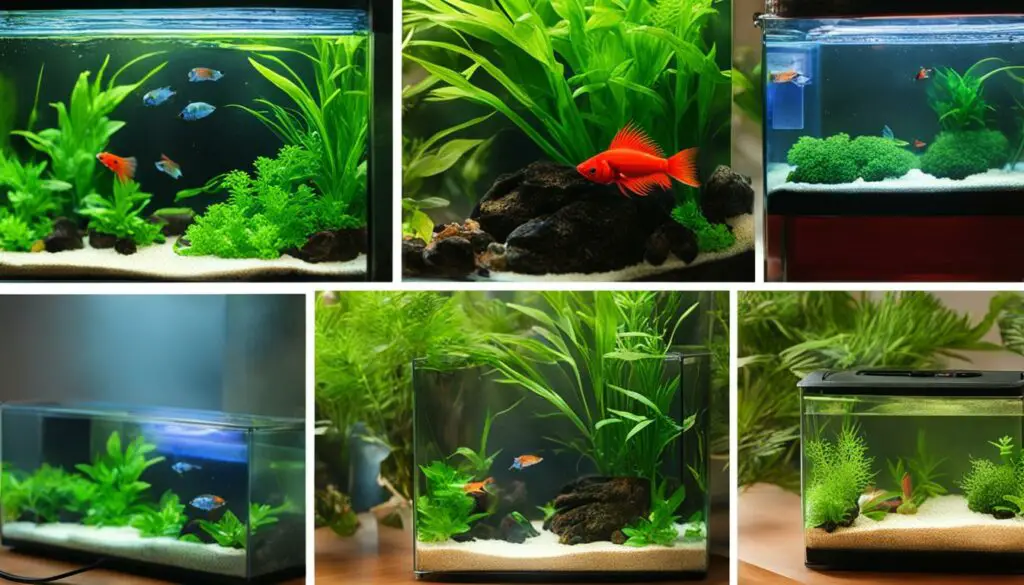
Expert Tip:
When using additional warming methods, be sure to monitor the temperature closely to prevent overheating or temperature fluctuations. Always use a thermometer to measure the water temperature regularly.
Tips for Preventing Temperature Fluctuations
Maintaining a stable temperature in your betta fish tank is key to ensuring the health of your fish. Here are some tips for preventing temperature fluctuations:
- Choose the right-sized heater: Make sure to choose a heater that is appropriate for your tank size. A heater that is too small won’t be able to maintain the optimal temperature, while a heater that is too big can cause rapid temperature changes.
- Avoid placing the tank near windows or doors: Excessive exposure to sunlight or cold drafts can cause temperature fluctuations in your tank. Therefore, to maintain a stable temperature, keep your betta fish tank away from any windows or doors.
- Insulate the tank: Insulating your tank can help regulate the temperature by preventing heat loss. You can use a tank cover or wrap the tank with insulation material such as foam to keep the heat inside.
- Keep the tank away from heat sources: Avoid placing the tank near heat sources such as radiators or heaters, as these can cause temperature fluctuations in the water.
- Monitor the temperature regularly: Check the temperature of your tank regularly using a thermometer. This will allow you to quickly identify any fluctuations and make adjustments as necessary.
By following these tips, you can ensure that your betta fish tank maintains a stable temperature, which is crucial for the optimal health and well-being of your fish.

Tips to Avoid Common Betta Fish Tank Warming Mistakes
Warming up a betta fish tank can be challenging, and there are some common mistakes that many fish owners make. To ensure your betta fish stay happy and healthy, avoid these mistakes:
1. Using a Low-Quality Heater
Choosing a low-quality heater can lead to inconsistent temperature regulation, which can be harmful to your betta fish. Invest in a high-quality heater that comes with a thermostat to ensure accurate temperature regulation.
2. Overheating the Tank
While maintaining a consistent temperature is essential, overheating the tank can be equally dangerous. Overheating can lead to oxygen depletion, which can cause stress, illness, or even death to your betta. Monitor the temperature regularly to ensure it remains within the optimal range.
3. Neglecting Water Changes
Without regular water changes, the water quality can significantly decline, which can impact the health of your betta fish. Make sure to perform water changes regularly, following the instructions based on the size of your tank and the number of fish you have.
4. Placing the Heater Incorrectly
Placing the heater in the wrong location can lead to uneven temperature distribution in the tank. Ensure that you place your heater close to the water flow, where the water temperature is most consistent.
5. Forgetting to Monitor the Temperature
While it is important to invest in a high-quality heater, it is equally important to monitor the temperature regularly to ensure that it remains consistent. Sudden temperature changes can be harmful to your fish, so make sure you keep a thermometer in the tank and monitor the temperature regularly.
6. Ignoring Other Tank Factors
While temperature regulation is crucial, there are other factors to consider when creating a comfortable environment for your betta fish. These factors include water quality, tank accessories, and lighting. Make sure you provide your betta fish with a well-rounded environment for optimal health and happiness.
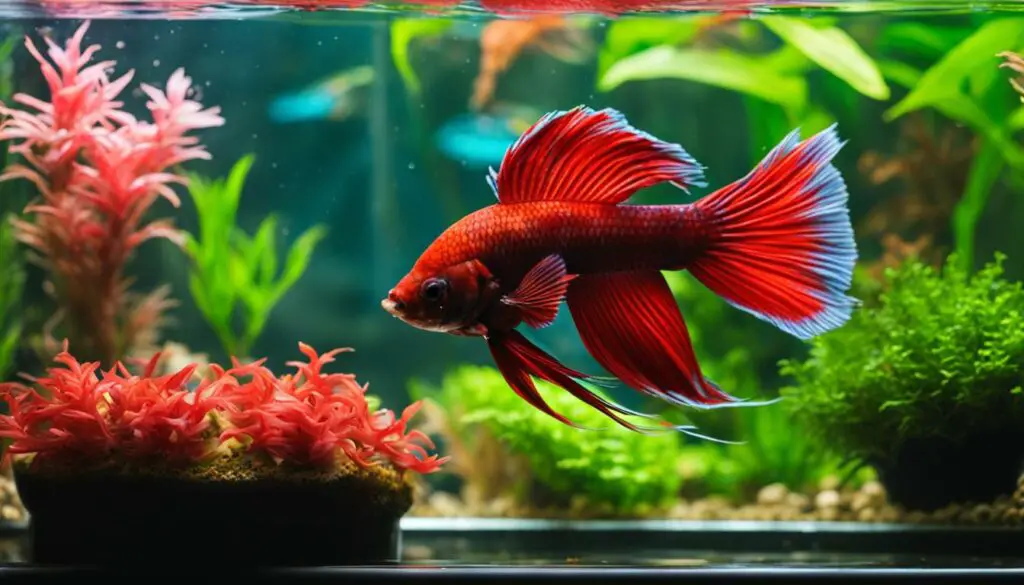
Maintaining Water Quality While Heating the Betta Fish Tank
While maintaining the right temperature is crucial for a healthy betta fish tank, it’s equally important to ensure proper water quality. Heating the tank can affect the water chemistry, so it’s essential to take extra precautions to keep your fish safe and healthy.
The first step in maintaining water quality is to invest in the right betta fish tank heater. Choose a heater that’s appropriate for the size of your tank and has adjustable temperature controls. A reliable heater will ensure that the water temperature remains stable, reducing stress on your betta fish and preventing sudden water chemistry changes.
In addition to choosing a quality heater, you can maintain water quality by keeping the tank clean. Perform regular water changes to remove debris, dissolved organic matter, and nitrate buildup, which can all affect water chemistry. Use a clean algae scrubber to remove any algae buildup on the tank walls, and vacuum the substrate regularly to remove debris.
It’s also essential to avoid overfeeding your betta fish, as uneaten food can cause excess waste buildup in the tank. Monitor the water chemistry regularly using a test kit and adjust your maintenance routine as needed to keep the water chemistry balanced.
One final tip for maintaining water quality while heating the betta fish tank is to ensure proper filtration. A quality filter will help remove waste and debris from the water, reducing stress on your fish and maintaining ideal water chemistry. Consider investing in a filter with adjustable flow rates to suit the needs of your betta fish.
Conclusion
Maintaining proper water quality is essential for the health and well-being of your betta fish, especially when heating the tank. Choose a quality heater, keep the tank clean, avoid overfeeding, monitor water chemistry regularly, and invest in a proper filter to ensure that your betta fish thrives in its environment.
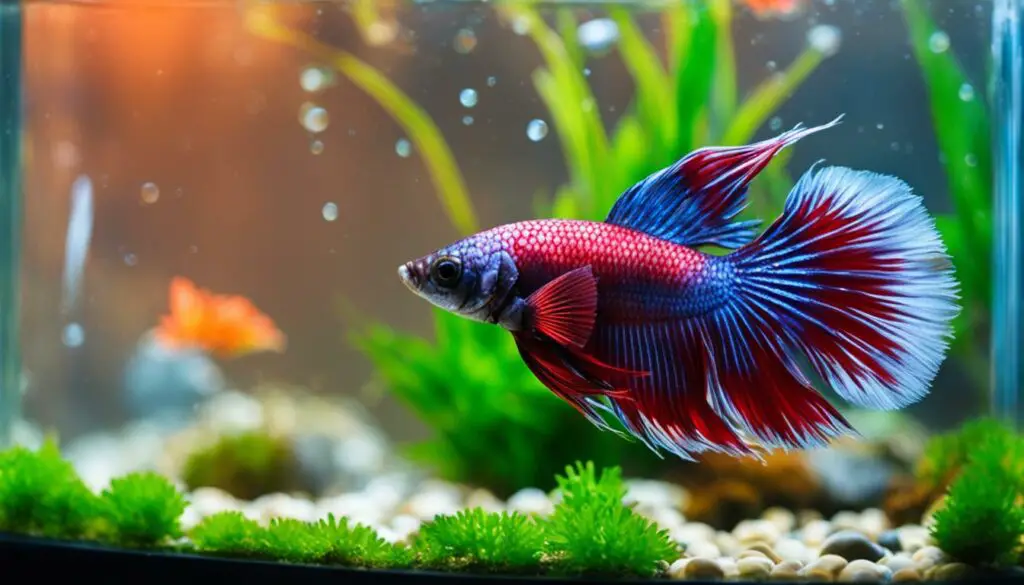
Providing a Comfortable Environment for Your Betta Fish
While maintaining the right temperature is crucial for your betta fish’s health, there are other factors to consider when providing a comfortable environment.
Essential Tank Accessories
Decorating your betta fish tank can be fun and exciting, but it’s important to choose accessories that are safe and comfortable for your fish. Avoid sharp objects or decorations with small openings that your betta can get easily trapped in. Opt for smooth rocks and plants that your betta can swim around and hide in.
You can also add a substrate at the bottom of the tank. Sand and smooth gravel are good options as they are easy to clean and won’t injure your betta.
Lighting
Lighting plays a crucial role in the health of your betta fish. It is essential to provide your betta with a regular light cycle of 8-12 hours per day, which can be achieved using an aquarium light timer. Keep the light intensity moderate and avoid direct sunlight as it can cause algae growth and temperature fluctuations.
General Care
To maintain a comfortable environment for your betta fish, it’s important to perform regular water changes and clean the tank. A good rule of thumb is to change 25-50% of the water in your betta fish tank once a week, depending on the size of the tank. Additionally, avoid overcrowding the tank with too many fish or other aquatic animals.
Betta Fish Tank Temperature
Remember to keep monitoring and adjusting the temperature of your betta fish tank even after setting up a heater. Maintaining the optimal temperature range of 76-81°F is essential for the well-being of your betta. Avoid sudden fluctuations in temperature, which can cause stress and health problems for your fish.
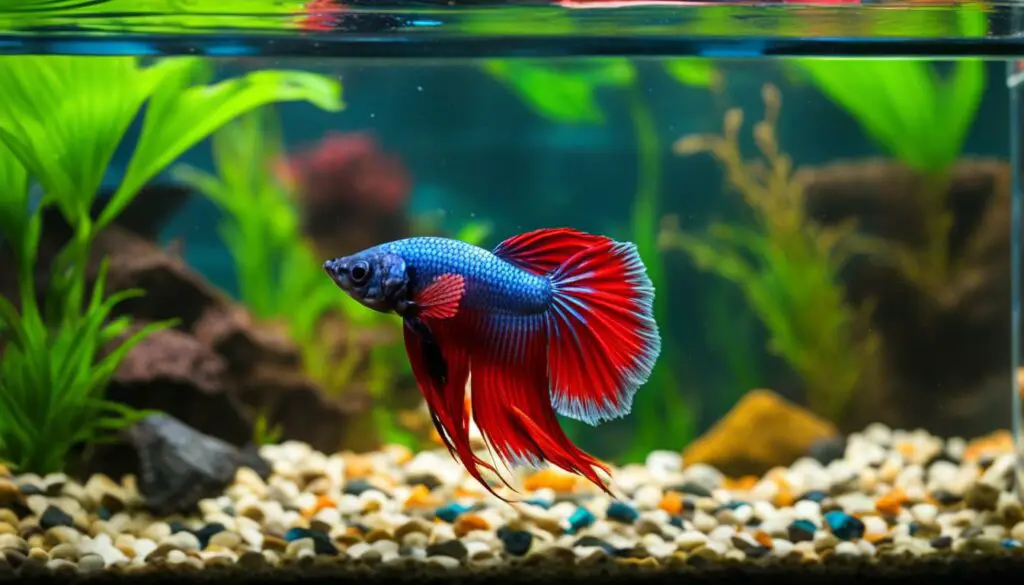
Providing a comfortable environment for your betta fish not only ensures its well-being but also brings joy to its owner. With proper temperature regulation, tank accessories, lighting, and general care, you can create a cozy and inviting home for your beloved betta fish.
Conclusion
Heating a betta fish tank can seem daunting, but with our easy guide, you can provide a cozy environment for your fish. Remember to choose the right heater, position it correctly, and monitor the temperature regularly to avoid fluctuations. Additionally, consider other ways to warm up your tank, such as using a thermometer or adding a warmer light.
Don’t Make These Common Mistakes When Warming Up Your Tank
By avoiding common mistakes, such as selecting the wrong type of heater or setting the temperature too high, you can keep your betta fish healthy and happy.
Provide a Comfortable Environment for Your Betta Fish
Along with maintaining the right temperature, ensuring your betta has suitable tank accessories and proper lighting is crucial. Make sure to keep their tank clean and provide a balanced diet to keep them thriving.
With these tips and tricks, you’ll be a pro at heating your betta fish tank and creating a comfortable environment for your beloved fish. Happy fishkeeping!
FAQ
Why is maintaining the right temperature important for a betta fish tank?
Maintaining the right temperature is crucial for the health and comfort of your betta fish. Betta fish are tropical fish and require a specific temperature range to thrive. Fluctuations in temperature can stress or even harm your fish, leading to potential health issues. It is essential to provide a stable and optimal temperature to ensure the well-being of your betta.
How do I choose the right betta fish tank heater?
Choosing the right betta fish tank heater is important to ensure a consistent and safe temperature for your fish. Consider the size of your tank and the wattage needed to heat it properly. Look for heaters that are adjustable and have built-in safety features such as automatic shut-off. It’s also beneficial to read reviews and seek recommendations from experienced fishkeepers to find a reliable and efficient heater for your betta fish tank.
Where should I place the heater in my betta fish tank?
Proper placement of the heater in your betta fish tank is crucial for effective temperature regulation. It is recommended to place the heater near a water flow area, such as the filter output, to ensure even distribution of heat. Avoid placing the heater too close to any decorations or plants to prevent damage. Regularly monitor the temperature to ensure it remains stable and within the optimal range for betta fish.
How do I set the desired temperature on the betta fish tank heater?
Once you have installed the heater in your betta fish tank, refer to the manufacturer’s instructions on setting the desired temperature. Most heaters have an adjustable thermostat that allows you to choose the temperature suitable for betta fish. It is recommended to set the temperature within the range of 78-82 degrees Fahrenheit (25-28 degrees Celsius) for optimal betta health. Regularly check the temperature to ensure it stays within this range.
How do I monitor and adjust the tank temperature?
Regular monitoring and adjustment of the tank temperature are necessary to ensure the comfort and well-being of your betta fish. Invest in a reliable aquarium thermometer to accurately measure the temperature of the water. If the temperature deviates from the desired range, make adjustments to the heater accordingly. It’s important to be vigilant and proactive in maintaining a stable temperature to prevent any sudden fluctuations that may stress or harm your betta fish.
Are there any additional ways to warm up a betta fish tank?
Yes, there are additional ways to warm up a betta fish tank if needed. You can use a tank cover or hood to help retain heat and insulate the tank. Placing a small, submerged aquarium-safe heater, like a mini heater or a preset heater, in a separate container of water and floating it in the tank can also provide localized warmth. However, it’s essential to ensure the overall water temperature remains within the appropriate range for bettas.
What are common mistakes to avoid when warming up a betta fish tank?
There are some common mistakes that fish owners often make when trying to warm up their betta fish tank. These include using inadequate or unreliable heaters, failing to regularly monitor and adjust the temperature, positioning the heater incorrectly, and neglecting to provide proper water circulation. It’s important to avoid these mistakes to ensure the well-being of your betta fish. Always research and follow proper guidelines for maintaining an appropriate and stable temperature in your betta fish tank.
How can I prevent temperature fluctuations in my betta fish tank?
Preventing temperature fluctuations is crucial for the health of your betta fish. Ensure that your betta fish tank is placed in a stable environment away from drafty areas or direct sunlight. Invest in a reliable heater with an adjustable thermostat and regularly check and calibrate its accuracy. Avoid sudden changes in room temperature and insulate the tank to maintain a stable and consistent temperature. Monitoring the tank regularly and reacting promptly to any temperature changes can help prevent fluctuations and keep your betta fish comfortable.
How do I maintain water quality while heating the betta fish tank?
Maintaining water quality is essential even when heating your betta fish tank. Regularly test the water parameters, such as ammonia, nitrite, nitrate, and pH levels, to ensure they are within the appropriate range for betta fish. Conduct regular water changes to keep the tank clean and remove any waste or excess nutrients. A heater can affect the rate of evaporation, so monitor the water level and replenish as necessary. Combining proper heating with proper water maintenance will help create a healthy and comfortable environment for your betta fish.
How can I provide a comfortable environment for my betta fish?
In addition to maintaining the right temperature, there are other factors to consider in creating a comfortable environment for your betta fish. Ensure your tank is adequately sized, providing enough swimming space for your betta. Add appropriate tank accessories, such as hiding spots, plants, and substrate, to mimic a natural habitat. Use proper aquarium lighting to simulate day and night cycles. Regularly clean the tank, monitor water parameters, and provide a balanced diet. By considering these factors, you can create an environment where your betta fish can thrive and be happy.

